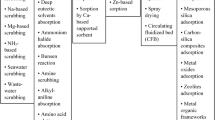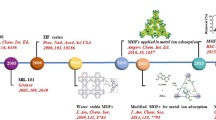Abstract
The coal chemical wastewater (CCW) was treated by anaerobic fluidized bed microbial fuel cell (AFB-MFC) with macroporous adsorptive resin (MAR) as fluidized particle. Isosteric heat calculation and molecular dynamics simulation (MDS) have been performed to study the interaction between organics of CCW and MAR. The isosteric heat of MAR to m-cresol was the largest at 65.4961 kJ/mol, followed by phenol. Similarly, the diffusion coefficient of m-cresol on MAR was the largest, which was 0.04350 Å2/ps, and the results were verified by the kinetic adsorption experiments. Microbial community analysis showed that the dominant bacteria in activated sludge of MFC fed with CCW were acinetobacter, aeromonas, pseudomonas and sulfurospirillum. The synergistic cooperation of bacteria contributed to improving CCW degradation and the power generation of MFC. Headspace-gas chromatography-mass spectrometry (HS–GC–MS) was used to detect intermediate of organics in CCW. It was proved that the intermediate of m-cresol degradation was 4-methyl-2-pentanone and acetic acid, and the intermediate of phenol degradation included cyclohexanone, hydroxyhexanedither and hydroxyacetic acid. Combined with the highest occupied molecular orbital (HOMO) analysis results of organic matter obtained by molecular simulation, the degradation pathway of organic matter in CCW was predicted. The energy of organics degradation pathway was analyzed by Materials Studio (MS) software, and the control step of organics degradation was determined.














Similar content being viewed by others
References
Liu C, Chen X-X, Zhang J, Zhou H-Z, Zhang L, Guo Y-K (2018) Advanced treatment of bio-treated coal chemical wastewater by a novel combination of microbubble catalytic ozonation and biological process. Sep Purif Technol 197:295–301
Huang Y, Hou X, Liu S, Ni J (2016) Correspondence analysis of bio-refractory compounds degradation and microbiological community distribution in anaerobic filter for coking wastewater treatment. Chem Eng J 304:864–872
Yu X, Wei C, Wu H, Jiang Z, Xu R (2015) Improvement of biodegradability for coking wastewater by selective adsorption of hydrophobic organic pollutants. Sep Purif Technol 151:23–30
Shi S, Qu Y, Ma Q, Zhang X, Zhou J, Ma F (2015) Performance and microbial community dynamics in bioaugmented aerated filter reactor treating with coking wastewater. Biores Technol 190:159–166
Niu Y, Liu X, Chang G, Guo Q (2020) Treatment of isopropanol wastewater in an anaerobic fluidized bed microbial fuel cell filled with macroporous adsorptive resin as multifunctional biocarrier. Sci Total Environ 719:137495
Yaqoob AA, Ibrahim MNM, Rodríguez-Couto S (2020) Development and modification of materials to build cost-effective anodes for microbial fuel cells (MFCs): an overview. Biochem Eng J 164:107779
Kong W, Guo Q, Wang X, Yue X (2011) Electricity generation from wastewater using an anaerobic fluidized bed microbial fuel cell. Ind Eng Chem Res 50:12225–12232
Liu XM, Niu YJ, Wang LY, Guo QJ (2020) Treatment of m-cresol wastewater in an anaerobic fluidized bed microbial fuel cell equipped with different modified carbon cloth cathodes. Energy Fuels 34:10059–10066
Palanisamy G, Jung H-Y, Sadhasivam T, Kurkuri MD, Kim SC, Roh S-H (2019) A comprehensive review on microbial fuel cell technologies: processes, utilization, and advanced developments in electrodes and membranes. J Clean Prod 221:598–621
Nguyen DT, Taguchi K (2019) Enhancing the performance of E. coli-powered MFCs by using porous 3D anodes based on coconut activated carbon. Biochem Eng J 151:107357
Benmakhlouf N, Azzouz S, Elcafsi A (2020) The determination of isosteric heats of sorption of leather: experimental and mathematical investigations. Arab J Chem 13:4286–4293
Fan W, Chakraborty A, Leong KC (2018) Theoretical and experimental investigations of isosteric heats for water adsorption on silica gel surfaces. Appl Therm Eng 141:134–142
Wang R, Wang J, Song Q (2020) The effect of Na+ and H2O on structural and mechanical properties of coal gangue-based geopolymer: molecular dynamics simulation and experimental study. Constr Build Mater 268:121081
Liu Y, Huang L, Shan M, Sang J, Li Y, Jia L, Wang N, Wang S, Shao S, Liu F, Lu F (2019) Enhancing the activity and thermostability of Streptomyces mobaraensis transglutaminase by directed evolution and molecular dynamics simulation. Biochem Eng J 151:107333
Chen Y, Li J, Wang F, Yang H, Liu L (2020) Adsorption of tetracyclines onto polyethylene microplastics: a combined study of experiment and molecular dynamics simulation. Chemosphere 265:129133
Guo F, Zhou M, Xu J, Fein JB, Yu Q, Wang Y, Huang Q, Rong X (2021) Glyphosate adsorption onto kaolinite and kaolinite-humic acid composites: experimental and molecular dynamics studies. Chemosphere 263:127979
Ghahghaey Z, Hekmati M, Darvish Ganji M (2020) Theoretical investigation of phenol adsorption on functionalized graphene using DFT calculations for effective removal of organic contaminants from wastewater. J Mol Liq 324:114777
Billeter SR, Curioni A, Andreoni W (2003) Efficient linear scaling geometry optimization and transition-state search for direct wavefunction optimization schemes in density functional theory using a plane-wave basis. Comput Mater Sci 27:437–445
Lee E, Rout PR, Kyun Y, Bae J (2020) Process optimization and energy analysis of vacuum degasifier systems for the simultaneous removal of dissolved methane and hydrogen sulfide from anaerobically treated wastewater. Water Res 182:115965
Lin M, Wang F, Zhu Y (2020) Modeled structure-based computational redesign of a glycosyltransferase for the synthesis of rebaudioside D from rebaudioside A. Biochem Eng J 159:107626
Liu XM, Wu JJ, Guo QJ (2017) Analysis of organic compounds’ degradation and electricity generation in anaerobic fluidized bed microbial fuel cell for coking wastewater treatment. Environ Technol 38:3115–3121
Shi W, Cang H, Xu W, Shao R, Yan X, Liu C-W, Chen C-L (2020) Dynamic behavior in lithium ion/graphene/propylene carbonate electrolyte systems through molecular dynamics simulation. Comput Mater Sci 174:109496
Yuan M, Gao M, Shi Q, Dong J (2020) Understanding the characteristics of water adsorption in zeolitic imidazolate framework-derived porous carbon materials. Chem Eng J 379:122412
Liu Y, Lu W, Wang H, Gao X, Huang Q (2019) Improved impact assessment of odorous compounds from landfills using Monte Carlo simulation. Sci Total Environ 648:805–810
Zhuang S, Chen R, Liu Y, Wang J (2020) Magnetic COFs for the adsorptive removal of diclofenac and sulfamethazine from aqueous solution: adsorption kinetics, isotherms study and DFT calculation. J Hazard Mater 385:121596
Ghasemi A, Asgarpour Khansary M, Marjani A, Shirazian S (2017) Using quantum chemical modeling and calculations for evaluation of cellulose potential for estrogen micropollutants removal from water effluents. Chemosphere 178:411–423
Park Y, Cho H, Yu J, Min B, Kim HS, Kim BG, Lee T (2017) Response of microbial community structure to pre-acclimation strategies in microbial fuel cells for domestic wastewater treatment. Biores Technol 233:176–183
Deng Q, Su C, Lu X, Chen W, Guan X, Chen S, Chen M (2020) Performance and functional microbial communities of denitrification process of a novel MFC-granular sludge coupling system. Biores Technol 306:123173
Han JL, Liu Y, Chang CT, Chen BY, Chen WM, Xu HZ (2011) Exploring characteristics of bioelectricity generation and dye decolorization of mixed and pure bacterial cultures from wine-bearing wastewater treatment. Biodegradation 22:321–333
Liu XW, Li WW, Yu HQ (2014) Cathodic catalysts in bioelectrochemical systems for energy recovery from wastewater. Chem Soc Rev 43:7718–7745
Toh H, Sharma VK, Oshima K, Kondo S, Hattori M, Ward FB, Free A, Taylor TD (2011) Complete genome sequences of arcobacter butzleri ED-1 and Arcobacter sp. Strain L, both isolated from a microbial fuel cell. J Bacteriol 193:6411–6412
Michaelidou U, Ter Heijne A, Euverink GJW, Hamelers HVM, Stams AJM, Geelhoed JS (2011) Microbial communities and electrochemical performance of titanium-based anodic electrodes in a microbial fuel cell. Appl Environ Microbiol 77:1069–1075
Raghavulu SV, Modestra JA, Amulya K, Reddy CN, Venkata Mohan S (2013) Relative effect of bioaugmentation with electrochemically active and non-active bacteria on bioelectrogenesis in microbial fuel cell. Biores Technol 146:696–703
Fuchs G (2010) Anaerobic metabolism of aromatic compounds. Eur J Biochem 1125:82–99
Hassan H, Jin B, Donner E, Vasileiadis S, Saint C, Dai S (2018) Microbial community and bioelectrochemical activities in MFC for degrading phenol and producing electricity: microbial consortia could make differences. Chem Eng J 332:647–657
Harayama S, Rekik M (1989) Bacterial aromatic ring-cleavage enzymes are classified into two different gene families. J Biol Chem 264:15328–15333
Sanakis Y, Mamma D, Christakopoulos P, Stamatis H (2003) Catechol 1,2-dioxygenase from Pseudomonas putida in organic media–an electron paramagnetic resonance study. Int J Biol Macromol 33:101–106
Kim SI, Leem SH, Choi JS, Chung YH, Kim S, Park YM, Park YK, Lee YN, Ha KS (1997) Cloning and characterization of two catA genes in Acinetobacter lwoffii K24. J Bacteriol 179:5226
Acknowledgements
This work was supported by the Foundation of State Key Laboratory of High-efficiency Utilization of Coal and Green Chemical Engineering (2021-K20), and the National Natural Science Foundation of China (21706141).
Author information
Authors and Affiliations
Corresponding author
Ethics declarations
Conflict of interest
The authors declare that they have no known competing financial interests or personal relationships that could have appeared to influence the work reported in this paper.
Additional information
Publisher's Note
Springer Nature remains neutral with regard to jurisdictional claims in published maps and institutional affiliations.
Supplementary Information
Below is the link to the electronic supplementary material.
Rights and permissions
About this article
Cite this article
Niu, Y., Liu, X., Wang, L. et al. Study on the mechanism of anaerobic fluidized bed microbial fuel cell for coal chemical wastewater treatment. Bioprocess Biosyst Eng 45, 481–492 (2022). https://doi.org/10.1007/s00449-021-02672-x
Received:
Accepted:
Published:
Issue Date:
DOI: https://doi.org/10.1007/s00449-021-02672-x




